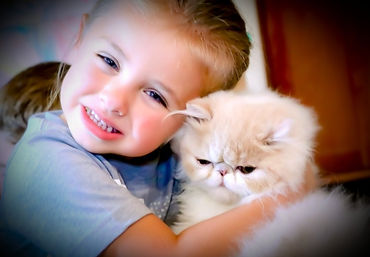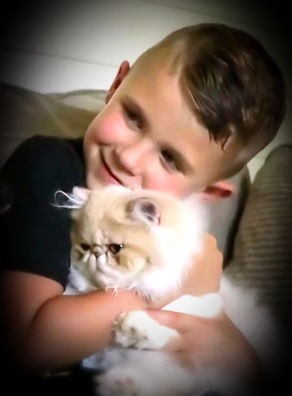
Grooming your New Persian:
_edited.jpg)
Grooming:
Use a metal wide tooth comb DAILY like clockwork EVERYDAY!!!! Comb down to the skin. I usually start with the ruff, move under each front leg down the tummy, down the back, and then back legs and sides. Then I do behind each ear and repeat around the ruff. I repeat the ruff and start with the ruff...because that's the part they like groomed. Do not let your cat be the boss in this department but don't break legs over it either. Regardless of how much they cry, bite the comb, hiss...keep combing everyday and one day it will become a bonding element between you and your kitten, and they will adore being groomed. I also use a flea comb for their face and behind the ears.
Nail clipping:
Kittens/Cats normally have five toes on each front paw and four per back paw. Try clipping the nails biweekly. Never clip past the white part of the nail, only clip the clear section. Spread each toe out and push the nail outward. Then clip where it looks clear, move on to the next nail. If your kitten fights this routine....don't let him think he's winning, even if he is. After you try to do each nail, even if you miss a nail or all, then and only then do you consider the nail clipping routine done. Sooner or later you will get all nails and he will stop fighting. Some breeders prefer to clip after a bath when the nail is softer. Front nails need to be clipped twice as often as back nails. I generally keep a calendar of bathing and nail trimming routines. If you cut the nail too far and it bleeds, monitor it well and apply a little pressure to stop the bleeding. A little peroxide might be needed in some cases. All kittens leave Neshama Sheli with freshly clipped nails and a bath.
Ears:
Clean ears with a cotton ball or Q-Tip, but only clean out what you can see! Never enter the ear canal, leave that to the vet! Do ears after the bath. Be careful not to allow water from the bath into the ears, and cautiously around the mouth and nose not to drown your Persian kitty. We have found that the powdered Boric Acid is great for drying the ears.
The Bath:
Baths should be done whenever the fur is wanting to mat, or at least once every 3 -4 weeks. Greasy coats cause knots and mats. Always degrease and rinse better than you think you need too! I use regular Hand GOOP and the BLUE regular dawn dish liquid(ONLY) to degrease with. Please do NOT use lemon , orange, or any scented Dawn, as it can burn their eyes and skin. Males do have a tendency to get stud tail on their privates and on their tail, so please make sure to degrease and then rinse very well. After degreasing you can then use your regular kitten/cat shampoo and conditioner. I always float the coat when bathing and rinsing. You can google how to do this properly. I also use a concentration of 20% baby shampoo to 80% water on the face and head area.
After you have bathed your cat, If your kitten/cat’s fur feels sticky or is matting when drying or if he/she returns to the water bowl to soak his/her face or ruff... you didn't rinse good enough. Left over residue burns their sensitive skin. The water bowl is their way of cooling the heat down. This in itself can cause skin irritations so please re-rinse and dry again. A good rule of thumb is if you think you have rinsed good enough then rinse one more time.
Eyes in Persians, and Persian Kittens
Yes, the eyes water and even in a rust color in some localities! It isn't just because of the breeding of extremeness. Many Kittens tear during the teething stages and may even develop an eye infection if the eyes are not properly washed daily during the teething stages. Dust in air, pollen, fresh air during allergy seasons, carpet, Dust from the litter in the litterbox are ALL causes for Persian kittens and cats to have watery eyes. I have found that warm water on a washcloth and gently wiping the eyes and fur around the eyes works wonders. I also dry them with a bounty napkins cut up into little strips. The napkins absorb more of the water and dry the area around the eyes better. If you can stay on top of the watery eyes of the kitten during teething, then as an adult, the Persian eyes should hardly water, if they water at all. If the eyes are not looked at and washed good during the kitten's teething stages, you'll have dripping eyes for life! This stage starts at age 10 weeks and continues until about 8 months of age on and off. I sometimes clean kittens/cats eyes twice a day, AM and PM. I have found that this will help them during the teething process.
Minor/Major Health:
At placement, all Neshama Sheli kittens/cats will have had all of their age appropriate shots and will have their shot/medical records with them. Your Kitten/Cat has already been to the veterinarian for his/her medical check and health visit prior to leaving for his forever home.
Further Statements by Neshama Sheil Cattery
The easiest way to guarantee your cat will not contract FeLV is to keep all cats inside and be sure to have all new cats entering your home tested for FeLV before exposing them to your other cats. As for FIP, there is not a conclusive test to tell if your cat has FIP. According to the AAFP (American Association for Feline Practitioners) and the Academy of Feline Medicine, your vet cannot diagnose FIP by a titer test alone, and it is considered veterinary malpractice to do so. Combinations of other systems, such as fever, jaundice, anorexia, anemia, high gamma globulin, low serum albumin and clear yellow protein rich fluid in the abdomen are more reliable. The only test considered definitive for FIP is microscopic analysis of the cat's tissues (usually postmortem) preferably with analysis for the presence of the virus.
New owners are advised to discuss vaccination options with their own veterinarian, but most vets agree that all health guarantees are null and void if this cat is given a FeLV or FIP vaccine. Please be advised that if you choose to give this kitten the vaccines listed above the contract for this kitten/cat is Null and VOID. Neshama Sheli is a PKD1, FIV, and FeLV free cattery and uses only neg cats.
Should you or shouldn't you declaw?
We hope that NO animal ever becomes declawed! Declawing isn't just simply removing the top nail... it is cutting away the bone as well...It is in our eyes the same as cutting off your toes in order to assure the toenail never grows back. We strongly recommend against declawing. Declawing surgery is highly invasive and painful for your cat. It is also completely unnecessary as routine maintenance on your cat’s claws (keeping them trimmed) is all that is needed to protect your furniture and skin. Also, many cats that are declawed tend to bite. The worse consequences of declawing is that many cats will stop using their litter box, due to the pain in the paws. They will sometimes then associate the litter box with pain and never use it again. This problem is not easily fixed; the cat will usually refuse to use a litter box for life after declawing.
We hope we have answered any question you might have about what to do when bringing in a new member into your home. Please know that I am here anytime if you have any questions. Please feel free to contact me with any concerns or questions that you might have.
***Please wash your Persian face daily and cautiously. Select a routine time to clean the face and groom the kitten. Don't allow the eyes to become infected by not cleaning them regularly. Also Please Please brush/comb your Persian daily to keep them from getting matted and tangled. This is a MUST, and will help tp keep them Happy and Healthy.
